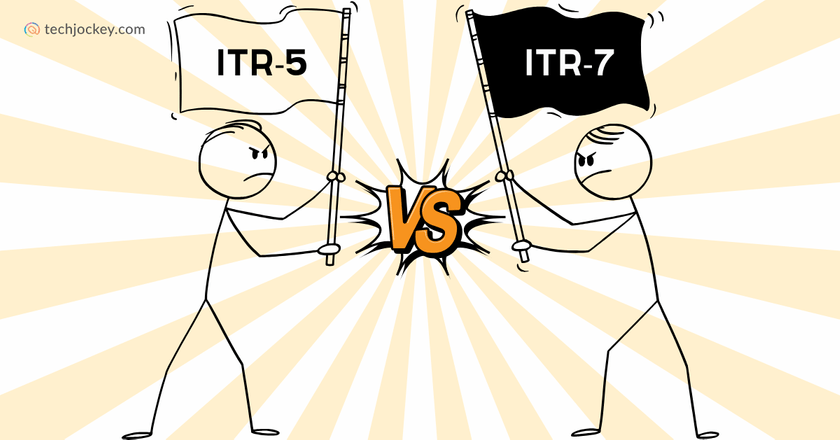ITR-5 vs ITR-7: Key Differences Every CA and Taxpayer Must Know

Filing income tax returns in India is crucial; filling out the right form for it even more so, especially when it comes to entities like firms, LLPs, trusts, and charitable organizations. For we have all, at some point in our lives, come across debates like ITR-5 vs ITR-7, but not many of us know how to differentiate between the two or more importantly, when and why to use each.
Let us answer all your queries pertaining to the same here in this write-up, so you know which form fits your entity’s profile in the best way possible.
What are ITR-5 and ITR-7?
ITR-5 is the income tax return form that non-corporate entities, like firms, LLPs, Associations of Persons (AOPs), Bodies of Individuals (BOIs), Artificial Juridical Persons, estates of deceased or insolvent persons, business trusts, and investment funds, are required to file.
Those filing ITR-5 report income from business or profession, capital gains, house property, lotteries, foreign income, and other sources. The form does not require extensive annexures, making it ideal for entities with taxable business income.
So. if your entity is required to get its accounts audited under Section 44AB or other provisions, filing ITR-5 is mandatory.
ITR-7, on the other hand, is targeted at entities that are eligible for exemptions under various sections of the Income Tax Act, including…
- Charitable or religious trusts (Section 139(4A))
- Political parties (Section 139(4B))
- Scientific research institutions, universities, and hospitals (Sections 139(4C) and 139(4D))
- Business trusts and investment funds under certain exemption clauses (Sections 139(4E) and 139(4F))
The form requires detailed disclosure on exempt income, donations received, fund utilization, compliance with various exemption rules, and foreign contributions as per the Foreign Contribution Regulation Act (FCRA).
Comparison Between ITR-5 vs ITR-7
| Parameter | ITR-5 | ITR-7 |
|---|---|---|
| Applicable Entities | Firms, LLPs, AOPs, BOIs, business trusts, estates of deceased or insolvent persons | Charitable/religious trusts, political parties, scientific/educational institutions, certain business trusts and investment funds claiming exemptions |
| Type of Income Reported | Business/professional income, capital gains, house property, lottery, other taxable sources | Mostly exempt income, donations received, application of funds for charitable, religious, political, or educational purposes |
| Income Tax Act Sections Covered | General provisions for taxable non-corporate entities | Exemption provisions under Sections 139(4A), 139(4B), 139(4C), 139(4D), 139(4E), 139(4F) |
| Audit & Compliance | Audit required under Section 44AB if turnover/income crosses threshold | Detailed records and audit related to exempt income compliance under Sections 11 & 12 |
| Filing & Verification | Online or physical filing, digital verification possible | Exclusive online filing, digital verification via DSC mandatory |
| Form Complexity & Disclosure | Relatively simple; focused on business income and tax calculations | More elaborate; multiple parts/annexures covering donations, fund utilization, accumulated income, and foreign contributions |
| When to File | Entities engaged in taxable business or professional activities | Entities claiming exemptions like charitable trusts, religious institutions, political parties, scientific/educational bodies |
Key Difference Between ITR-5 and ITR-7
Understanding the difference between ITR-5 and 7 is essential for correct filing. Let’s explore it in detail…
1. Applicability & Eligible Entities
- ITR-5 is for commercial and taxable non-corporate entities such as firms, LLPs, AOPs, and business trusts. These entities generally carry out profit-making business or professional activities and do not fall under tax-exempt categories.
- ITR-7, on the other hand, is reserved for entities that qualify for income tax exemptions under specific sections, such as charitable trusts, religious institutions, political parties, educational and scientific organizations. These entities are primarily concerned with transparency around exempt income and regulatory compliance.
2. Types of Income Reported
- Entities using ITR-5 report income from business or profession, capital gains, house property, lottery winnings, and other taxable sources. Their income is generally subject to tax, barring allowable deductions.
- Entities filing ITR-7 report mostly exempt income or income used for charitable, religious, political, or educational purposes. The form captures details on voluntary contributions, application of income for exempt purposes, accumulated income, and compliance with exemption conditions.
3. Sections of the Income Tax Act Covered
- ITR-5 is used by entities outside the purview of exemption, basically taxpayers governed by general income tax provisions.
- ITR-7 filers, conversely, fall under exemption sections of the Income Tax Act such as 139(4A), (4B), (4C), (4D), (4E), and (4F), requiring disclosures aligned with these provisions.

ClearTax Income Tax
Starting Price
Price on Request
4. Audit & Compliance Requirements
- Entities filing ITR-5 are subject to a udit requirements under Section 44AB if their turnover or income crosses thresholds.
- Filing ITR-7, in contrast, requires adherence to exemption-related audit formats and maintaining detailed records of how the income has been applied for charitable or exempt purposes, including compliance with Sections 11 and 12 of the Income Tax Act.
5. Filing Process & Verification
- ITR-5 allows online filing with options for digital verification and physical signed acknowledgment submissions, providing filing flexibility.
- ITR-7 filing, conversely, demands exclusive online submission with digital verification through DSCs due to the sensitive nature of exempt income reporting.
6. Form Complexity & Disclosure
- ITR-5 is relatively simpler, designed to collect data relevant to business income and tax calculations without complicated schedules.
- ITR-7, on the contrary, is more elaborate with multiple parts and annexures requiring detailed disclosure about donations, fund application, income accumulation, foreign contributions, and compliance with exemption laws.
How to Decide Between ITR-5 and ITR-7?
Choosing between ITR-5 and ITR-7 depends on your entity’s legal nature and income type…
- File ITR-5 if your entity is a firm, LLP, AOP, BOI, or business trust engaged in taxable business or professional income activities.
- Opt for ITR-7 if you represent a charitable or religious trust, political party, scientific or educational institution claiming tax exemption, or similar exempt entity.
Understanding the specific sections under which your entity is registered, and the nature of your income sources will guide you. If in doubt still, consult a tax advisor or refer to Income Tax Department notifications.
For filing the wrong form can result in penalties or prolonged processing, making informed selection absolutely necessary.
Conclusion
In the comparison of ITR-5 vs ITR-7, the primary distinction lies in the entity’s tax status. Understanding this makes certain your tax filings are accurate, sparing you the trouble of legal issues and facilitating smooth processing of returns.
So, if you are a firm, trust, or organization looking to file your ITR form, reach out to the Techjockey product team today itself and get access to the best income tax software to simplify the process.
Yashika Aneja is a Senior Content Writer at Techjockey, with over 5 years of experience in content creation and management. From writing about normal everyday affairs to profound fact-based stories on wide-ranging themes, including environment, technology, education, politics, social media, travel, lifestyle so on and so forth, she... Read more




























